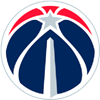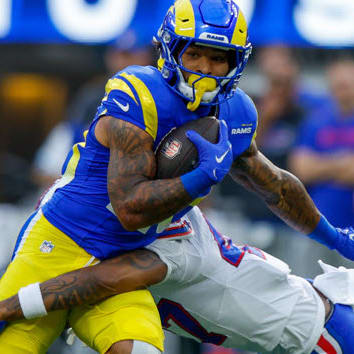This is the quarterback and tight end component of the post-combine dynasty rankings. You can read the updated running back rankings by clicking here, while the wide receiver post will go up Friday Saturday, very sorry.
QUARTERBACKS
1. Anthony Richardson, Florida (6-4, 244)
Lamar Jackson is the best rushing threat at quarterback ever, but Richardson is probably the best overall athlete among all NFL quarterbacks in league history. To run a 4.43-second 40 at 244 pounds is just outrageous, and Richardson has the arm to strike downfield if defenses try to crash toward the run. Richardson's alarmingly poor passing production at Florida raises the understandable fear that this best-ever athleticism might not amount to much at the NFL level, but players with tools like these play on a lower difficulty level than everyone else. With tools this loud any improvement in Richardson's skill set will yield a much higher rate of return than the same amount of improvement by any other quarterback. If the light goes on with Richardson the results will be explosive, maybe even singular.
Previous projection: Round 1
New projection: Round 1 (Top five)
Comparison: ?
2. C.J. Stroud, Ohio State (6-3, 214)
The weigh in was light, but Stroud didn't do anything to meaningfully affect his (high) stock. Daniel Jeremiah was a big fan of Stroud's passing workout, for what it's worth.
Previous projection: Round 1 (Top 10)
New projection: No change
Comparison: Teddy Bridgewater
3. Bryce Young, Alabama (5-10, 204)
Young weighed in at a good number, it just isn't clear how meaningful it is, especially since he didn't do any running or jumping. If Young had run or/and jumped and tested well it would have proven he could weigh 204 pounds and move at an athletically acceptable level. All we know instead is that Young happened to weigh 204 pounds that day. We also know he didn't play at Alabama at that weight. We don't know whether he can play with that weight, nor do we know if he can keep it on. I still think he slips but the betting markets continue to favor him to be the first quarterback selected.
Previous projection: Top 50
New projection: Round 1
Comparison: Doug Flutie
4. Will Levis, Kentucky (6-4, 229)
Levis' jump numbers (34-inch vertical, 124-inch broad jump) were excellent and his weigh in was very good as well, but Levis' sales pitch already made note of such details all along. Levis' stock probably didn't change, and he likely remains a good bet to go in the first five picks despite a fair amount of protest.
Previous projection: Round 1 (Top five)
New projection: No change
Comparison: EJ Manuel
5. Hendon Hooker, Tennessee (6-3, 217)
Hooker could not test at the combine due to his ACL injury, so nothing is new with him. Hooker is interesting as a dual-threat prospect, but his injury, age (turns 26 in January) and questionable collegiate systems make him an unconventional and uneven prospect. Hooker was good at Virginia Tech before he was excellent at Tennessee, but the Volunteers offense resembles almost nothing Hooker will see in the NFL.
Previous projection: Round 2-3
New projection: No change
Comparison: Bryce Petty
6. Clayton Tune, Houston (6-3, 220)
Players like Tune rarely do anything at the NFL level, and he's no guarantee to even make a roster, but I think he's more likely to stick than quarterbacks like Max Duggan. Unlike Jake Haener, who I also prefer to Duggan, Dorian Thompson-Robinson, etc., Tune has the athleticism and frame to project as a rushing threat at the NFL level, making him more interesting for fantasy as a fringe consideration in 2QB or superflex leagues. Tune ran a 4.64 40 and posted borderline elite athletic testing across the board otherwise. Tune improved steadily in his four years as starter at Houston, giving hope that he can continue to fix up the otherwise rough parts of his game as a passer.
Previous projection: None
New projection: Round 4-6
Comparison: Gardner Minshew
TIGHT ENDS
1. Michael Mayer, Notre Dame (6-5, 249)
I am not scared off of Mayer at all, but his combine was objectively disappointing. He weighed in 11 pounds less than expected, yet his 4.7-second 40 time wasn't much to show for the weight loss. If Mayer had run a 4.75 at 255 pounds it would have been a more useful time. Mayer's testing confirms he's unlikely to make a downfield impact as a tight end, but there's still every reason to believe he can be a high-volume tight end target with better than average efficiency.
Previous projection: Round 1 (Top 20)
New projection: Round 1
Comparison: Upgraded Zach Ertz
2. Dalton Kincaid, Utah (6-4, 246)
Kincaid did not do any combine testing, but his 246-pound weight is good if he can test well on it at the Utah pro day. Kincaid has been projected as a first-round pick by Mel Kiper and Daniel Jeremiah for some time, so my Round 2 projection might seem stingy but I'm open to moving him up depending on how he tests.
Previous projection: Round 2
New projection: No change
Comparison: Todd Heap
3. Darnell Washington, Georgia (6-7, 264)
Washington still doesn't look like a volume-capable target as a tight end, but after his combine showing it might be worth considering that he could pose an uncommon threat on a per-target basis, to the point that he ends up a top-10 fantasy tight end at some points even while ranking at the bottom of that group in target count. For a defense to counter the blocking threat posed by Washington they basically need to put a proper 4-3 defensive end over or near him. That's not practical for a defense, because a down lineman can't cover Washington, so more likely they have to try to counter him with a heavy safety or lighter linebacker, which is a body type likely to be no taller than 6-foot-3. There just isn't a way to counter the threats posed by Washington without leaving yourself more vulnerable to the alternative, and if you don't guess correctly with your personnel + playcall before the snap you could watch someone – be it an RB, mobile quarterback or Washington himself – galloping freely down the seam of your defense.
Previous projection: Round 2
New projection: Round 1-2
Comparison: ½ Marcedes Lewis, ½ Martellus Bennett
4. Sam LaPorta, Iowa (6-3, 245)
I lowered LaPorta's draft slot projection a little but I think he actually did great at the combine and made clear that he's a likely standout pass-catching tight end in the NFL. I'm lowering his draft slot selection slightly more because of how much stronger the rest of the tight end class is than I realized, with Luke Musgrave especially throwing a wrench in my understanding of the market. I previously figured only Mayer, Kincaid and Darnell Washington to go ahead of LaPorta, but as much as I think LaPorta is better it's clear that Musgrave will be drafted ahead of him, perhaps by as much as a round. The later LaPorta goes, the greater the likelihood that his arrival is delayed even if he's a good player. It's arguably reckless that I'm even listing him this high, but for what it's worth LaPorta is clearly better than Greg Dulcich – perhaps the Jets will take LaPorta in the third round if he shows up to team interviews with a hilarious mustache.
Previous projection: Round 2
New projection: Round 2-3
Comparison: Owen Daniels
5. Luke Musgrave, Oregon State (6-6, 253)
That I still rank Musgrave behind LaPorta after previously acknowledging Musgrave's higher draft stock is not done out of stubborn spite – I just truly don't see many scenarios where Musgrave catches more passes than LaPorta in the NFL. It seems borderline out of the realm of possibility to me, actually. There's still a case to taking Musgrave over LaPorta and then trying to flip Musgrave for LaPorta + more, and I certainly tip the cap to anyone who can pull that off, but for these rankings I just wanted to make clear which players I think will produce the most.
Musgrave appeals to more teams and is more versatile as a tight end than LaPorta, to the point that even I would concede there's a chance Musgrave is the better real-life tight end between the two. LaPorta won't help anyone as a blocker, and he's not bullying anyone in the air. Musgrave has the reach to credibly concern the defense's edge containment, and with 4.6 speed Musgrave poses a big playaction threat, not unlike Washington.
If Musgrave were to draw targets at a clip comparable to LaPorta, though, then I think he would have shown more in 2021, his age-21 season. While it was technically his junior year, the age-21 season is usually the senior year for most prospects who didn't have redshirt or transfer delays. We want to see prospects really flexing by this point, because it's where they begin to pass the average age on the field, at which point the value of their production wanes with time. Musgrave was off to a red-hot start in 2022, for instance, drawing 29.4 percent of Oregon State's targets against Fresno State and Boise State while producing 11 receptions for 169 yards and a touchdown (73.3 percent caught, 11.3 YPT), but because he was 22 years old he was three or more years older than most of his competition. If Musgrave's draft hype is premised on utility as a receiver specifically, then he should have been able to do better than just 22 receptions for 304 yards and one touchdown on 40 targets in 2021 (55.0 percent caught, 7.6 YPT). That's below-baseline efficiency while providing just 10.8 percent of Oregon State's receiving volume. Brutal!
Previous projection: Round 3-4
New projection: Round 2 (Top 50)
Comparison: Luke Willson
6. Tucker Kraft, South Dakota State (6-5, 254)
I'm concerned enough about Musgrave that I almost ranked him behind Kraft, who I neglected to rank at all in the pre-combine post. I just underestimated how popular he is, and how likely he is to get drafted at an enviable slot. Credentialed insiders have all but declared him a Day 2 commodity. If Kraft sees playing time then he should have real fantasy utility, because he's a big tight end with very good athleticism, even by the standards of players smaller than him. He ran the same 40 time as Dulcich (4.69), for instance, but at 11 pounds heavier. His 122-inch broad jump was also excellent even before adjusting for build. I still ultimately see Kraft as more toolsy than skilled in the meantime, but it seems like he should be at least an average starter at some point in his career.
Previous projection: N/A
New projection: Round 2-3
Comparison: Dawson Knox
7. Payne Durham, Purdue (6-6, 253)
Durham checked in taller and lighter than expected, which isn't ideal for a player whose game is built on inline power and making catches in traffic in the middle of the field. He did well other than that. His 4.87-second 40 was poor but expected – Purham was never a seam threat even in theory – so what's more important is that he did well in measures of short-area explosiveness. Durham's 1.61-second 10-yard dash ranks as a 73rd percentile figure according to Mockdraftable, while his 34.5-inch vertical and 117-inch broad jump were also both safely above average. The problem with Durham is that he projects as a plus blocker, a detail that might make it difficult for him to emerge as much more than a 50- or 60-catch tight end at the NFL level, and since he operates underneath he's unlikely to have a great deal of yardage to show for it. The way Durham could work in fantasy is if he ends up with a three-down role in an offense that throws for a lot of touchdowns. Durham gets better as a receiver the smaller the field gets.
Previous projection: Round 2-4
New projection: Round 3-4
Comparison: Tyler Higbee
8. Josh Whyle, Cincinnati (6-7, 248)
Whyle would ideally add some weight and get closer to 260 pounds, because that would provide him with a much better anchor and he has speed to spare after logging a 4.69-second 40-yard dash. Whyle seems to have some skill otherwise, flashing the ability to contribute as both a receiver and blocker. He might not be able to do much until he adds that weight to his frame, though.
Previous Projection: Round 3-4
New projection: Round 3-5
Comparison: Colby Parkinson
9. Zack Kuntz, Old Dominion (6-7, 255)
Kuntz is a very tall, extremely athletic tight end who might make less sense in practice than he does on paper. His athleticism is memorably freakish – his 40 (4.55), vertical (40 inches), broad jump (128 inches) and agility score (10.99) are all elite – but Kuntz's production at Old Dominion gives reason to question whether that raw athleticism is actually harnessed in the form of functional athleticism.
Kuntz couldn't get on the field in three years at Penn State, then he sat out a year due to transfer rules, then he played 18 games at Old Dominion from ages 22 to 23. Those are basically fifth- and sixth-year ages. He caught 85 passes for 836 yards and seven touchdowns on 138 targets. That's a catch rate of 61.6 at 6.1 yards per target. Kuntz's target rate was encouraging, but the returns were dubious at best. Not only are Kuntz's catch rate and YPT figures objectively awful, they were arguably even worse than the Old Dominion baseline. In that same sample Old Dominion completed 57.5 percent at 6.8 yards per target. It's arguable about where Kuntz's combined catch rate and YPT grade as above the Old Dominion baseline, but to me 0.7 yards per target is generally worth more than 4.1 catch percentage points. Basically, Kuntz took 24.8 percent of Old Dominion's targets but yielded only 22.3 percent of Old Dominion's receiving yardage.
Previous projection: N/A
New projection: Round 4-5
Comparison: Kellen Davis
10. Will Mallory, Miami (FL) (6-5, 239)
Mallory is kind of interesting and figures to draw some interest for his pass-catching upside, especially after he ran a 4.54-second 40-yard dash at the combine, but there are a few things to keep in mind. The first is that despite that speed, Mallory never emerged as a high-volume pass catcher in Miami. That's concerning especially because he will turn 24 in June. For someone as fast as him at that age the expectations become more strict, the failure to reach them usually only explained by a skill set deficit. The second thing to keep in mind is that Mallory is perilously light at 239 pounds, especially for someone of his height. He'd be better off at 6-foot-3 than 6-foot-5, because when you add height without adding weight you just make the player easier to grab and push around. That's the main concern with Mallory, whose short arms might make it difficult for himself to respond to the physicality he's likely to see.
Previously projection: Round 4-6
New projection: No change
Comparison: Shawn Nelson






































